Chiang Rai is situated in the North of Thailand, on the border of Myanmar and Laos. While the younger city (Chiang Mai) has become the main attraction when people visit the North of Thailand, Chiang Rai still remains uncommon to most visitors in Thailand.
General Information
Founded in 1262 in the Lanna Kingdom (now Northern Thailand), Chiang Rai was the first capital of King Meng Rai’s principality. These days, it’s a perfect destination for travelers who want to slow down, escape into nature and enjoy the charm of Northern Thailand’s smallest – sometimes equally frenetic – city. Here’s our guide to the city, covering everything from how to get there and the best place to stay.
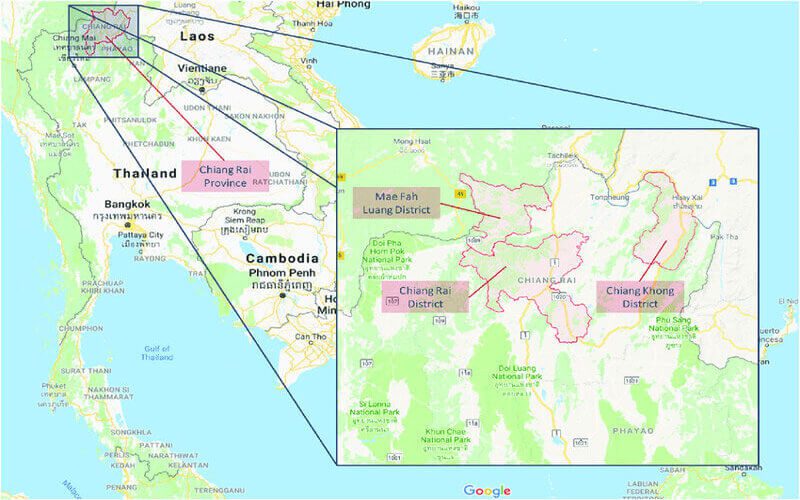
Chiang Rai in the North of Thailand
Weather and Best Time to Visit Chiang Rai
The city is surrounded by green plains and rivers, which make it cooler and less humid than many other places in Thailand. The average temperature is 24 °C (75 °F), it can reach 36 °C (97 °F) and drop to 10-15 °C (50-59 °F) at night during the cool season.
Here in Chiang Rai, there are 3 seasons per year:
- The Cool season (October-February): During the cool season, the temperatures during the day and the night are different remarkably. The average daytime temperature is 21 °C (70 °F) and at night can drop to 10-15 °C (50-59 °F). The season is ideal for outdoor activities.
- The Hot season (March-May): The average temperature in March is 27 °C (81 °F), but it increases in April and can reach 36 °C (97 °F) at the end of May. In the hot season, you can visit waterfalls like Huai Kaew and Huai Mae Sai to escape the heat. Alternatively, you can enjoy a traditional Thai lunch in a bamboo hut by the Kok River or visit the local market for a cold drink.
- The Rainy season (June-September): The average temperature in March is 27 °C (81 °F). Many travelers come to Chiang Rai for their summer holidays in July and August. The rain usually falls for 1–2 hours in the afternoon, so it won’t affect your movement too much. After the rain, the air is cooler and cleaner, as the temperature is quite high, so the rain would feel like a hot shower. Apart from the rain, the weather is a bit hot and humid during this season.
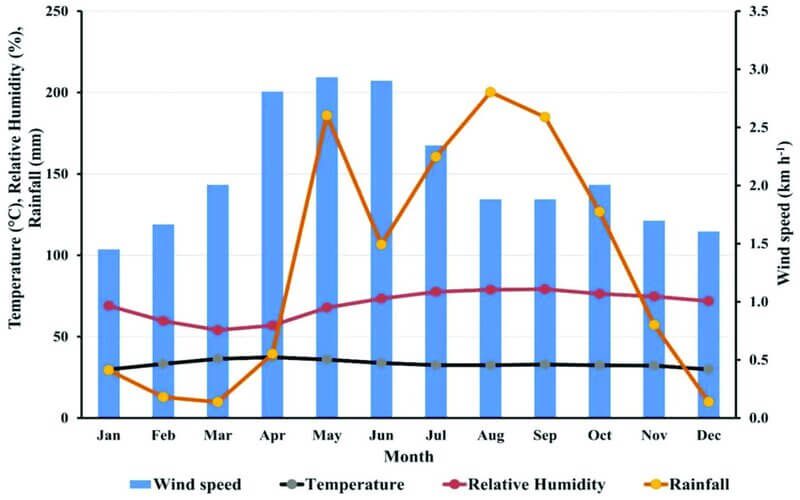
Weather in Chiang Rai – Thailand
Chiang Rai is a year-round destination for tourism, but the best time to visit is during the Cool season. The weather is cool and pleasant, you can see a clear sky that perfectly matched the beautiful green landscape. The rain rarely falls this season and the humidity is low. You can feel the fresh air while enjoying the clear sky and the green land. A walk at night is also a pleasant way to end the night.
How to Get to Chiang Rai
Plane
The plane is the fastest way to get to the city. The International Airport is just 10 km to the North of the city.
From Bangkok, it’s about a 1h30m flight but you can take a domestic flight from other Thai cities like Phuket, and Krabi. You can even combine your stay in another country and then come to Chiang Rai as the airport also have flights to Myanmar (Yangon), Cambodia (Phnom Penh, Siem Reap), Vietnam (Ho Chi Minh City) and Malaysia (Kuala Lumpur, Penang).
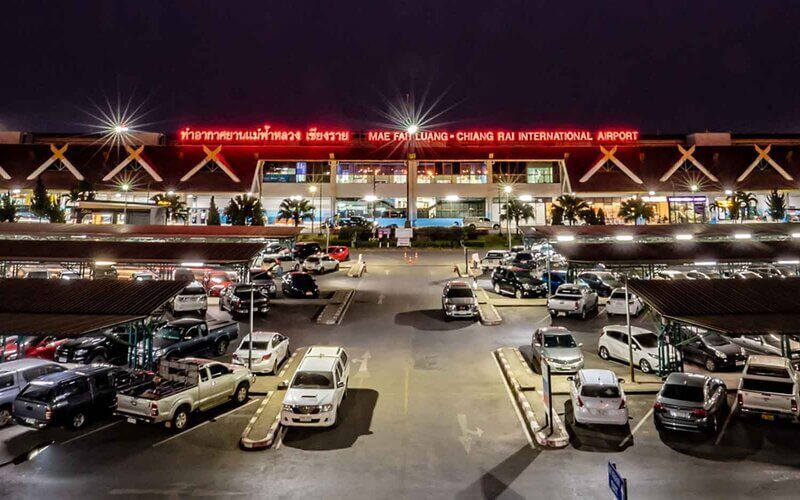
Chiang Rai International Airport
Bus
There are 2 bus stations in Chiang Rai: the old one is in the center and the new one is 7 km further south. Both are open and served by a Song Taew (shared taxi) service which will cost you around 15 bahts. The old station is primarily intended for journeys in the provinces of Chiang Rai and Chiang Mai. The new buses run from major Thai cities.
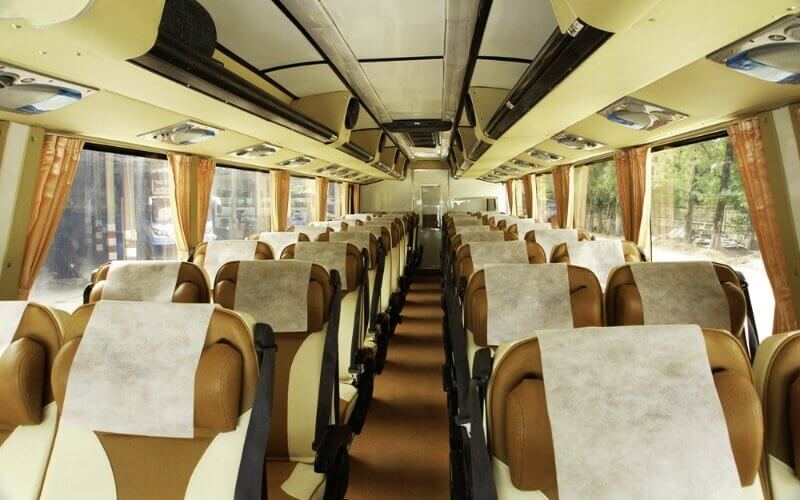
Chiang Rai Bus
Private car
Hiring a car with a driver is an ideal option if you want to reach Chiang Rai from anywhere in Thailand. Located in a mountainous area, it has many winding roads and some other means of transport do not allow access to many attractions in the remote areas. And so, IDC Travel recommends that you use a private car to get from place to place. Please contact us for more information.
Getting Around Chiang Rai
Songthaew
They are shared taxis and the cheapest way to get around the city. All you need to do is wave at them, tell them where you want to go and they will tell you if they are going that way too.
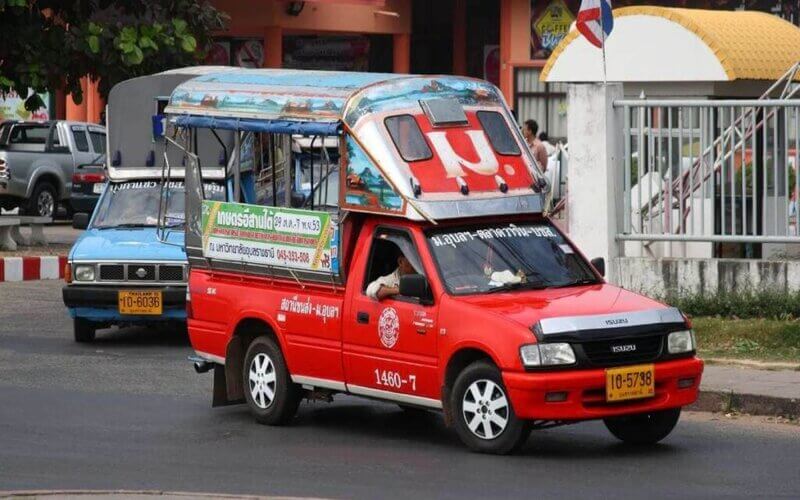
Songthaew
Tuk-tuk
Thailand’s signature tuk-tuk is a three-wheeled motorized rickshaw while samlor is a three-wheeled manual rickshaw. The latter can be a more convenient and cheaper option for traveling short distances. The minimum charge per person is around 30 bahts.
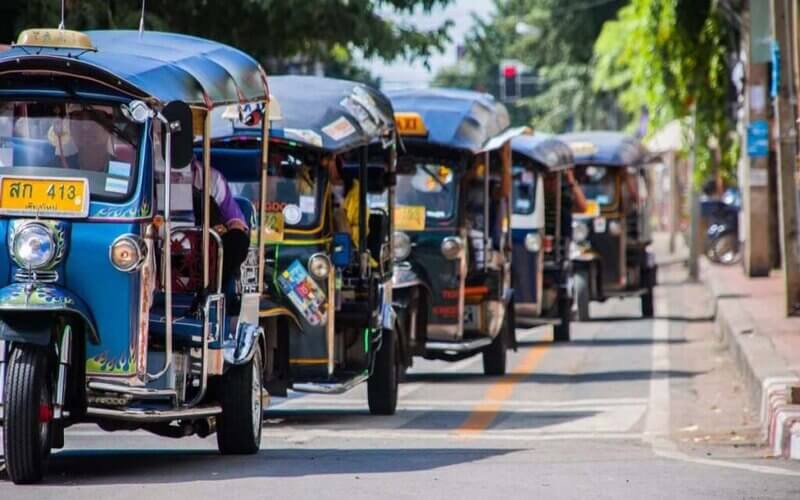
Tuk-tuk
Taxi
It is possible to take a taxi, but it is not always practical.
Bike/Scooter
Some tourists prefer to rent a bicycle or a scooter to get around town. Advise that the roads of Chiang Rai are quite hilly. This option will be suitable for those who have good stamina and are up for the challenge. Otherwise, it is ideal for a leisurely ride around the town.
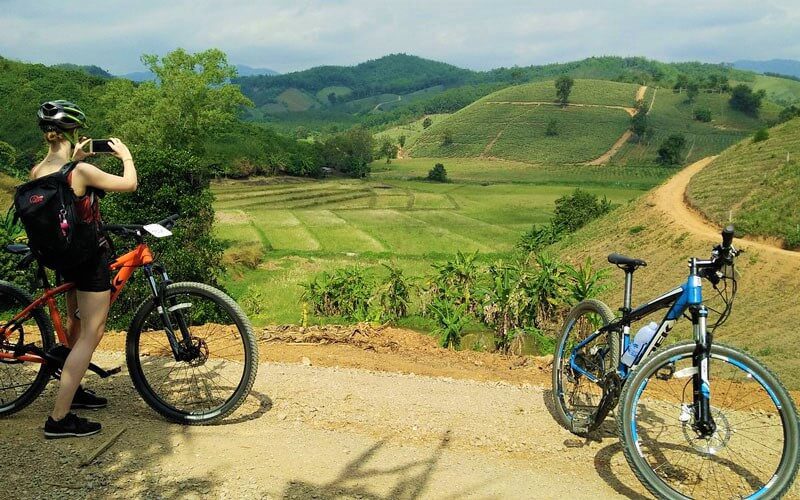
Bike ride in Chiang Rai
Accommodations in Chiang Rai
This city is an ideal place for travelers with many hotels, resorts, and guesthouses. Nature lovers can also go camping in the National Park. Typically, visitors would stay a day or two in or near the city center. There is never a shortage of hotels in Chiang Rai, ranging from 3 to 5-star hotels. Staying near or in the city will be easier to take a walk during your visit. For a peaceful and relaxing stay, choose a hotel that is outside the town. Chiang Rai’s high season is in December and January, this may cause the accommodation price to go up. Hotel prices in Chiang Rai would also depend on the location and amenities offered.
Standard hotel:
- Nak Nakara Hotel: 3*
Deluxe hotel:
- Laluna Hotel and Resort: 4*
- The Legend Chiang Rai Boutique River Resort & Spa: 4*
Luxury hotel:
- The Riverie by Katathani Chiang Rai: 5*
- The Heritage Chiang Rai Hotel & Convention: 5*
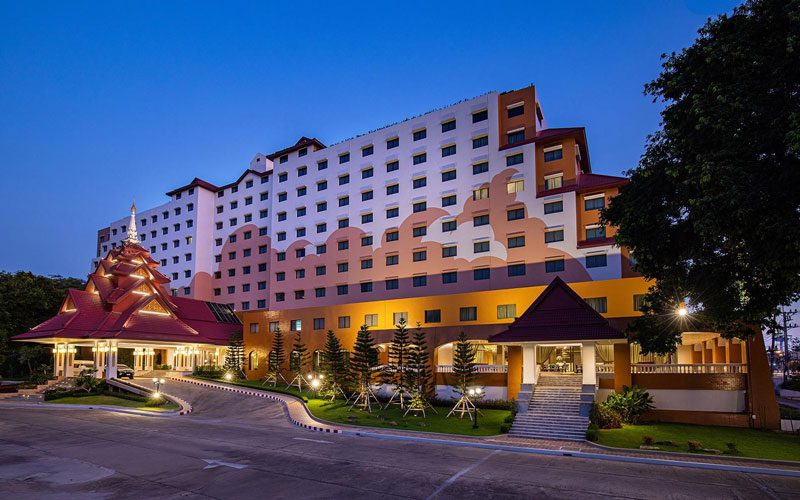
Heritage Chiang Rai Hotel and Convention
Best Places to Visit in Chiang Rai
Wat Rong Khun, White Temple
It is impossible to visit Chiang Rai without discovering the most famous site in the city, Wat Rong Khun, or the White Temple, located 13 km to the South. Many people come to Chiang Rai just to visit it. Wat Rong Khun is not an ancient temple with a big Buddha statue, its construction only started in 1997, and it’s not even finished yet. It is particularly built with a mixture of lime and mirror shards, which make it sparkle in the sun. You can find statues and magnificent carved and mirror details everywhere in the temple.
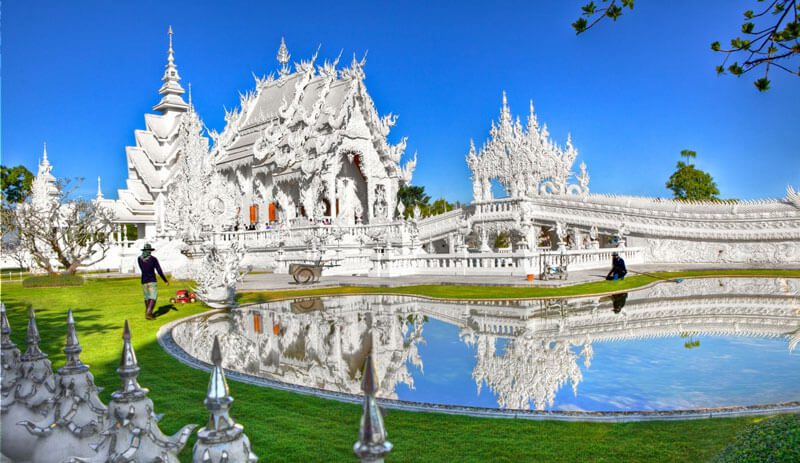
Wat Rong Khun – The White Temple
Wat Rong Suea Ten, Blue Temple
This Buddhist temple is easy to recognize thanks to its very bright blue building. It is adorned with gliding, a religious mural, and elaborate carvings. Built by a student of the artist who built the White Temple, much of the art and decor recall the style. However, the Blue Temple is quite unique and all of its adornments look extremely contemporary and modern compared to other temples in the area.
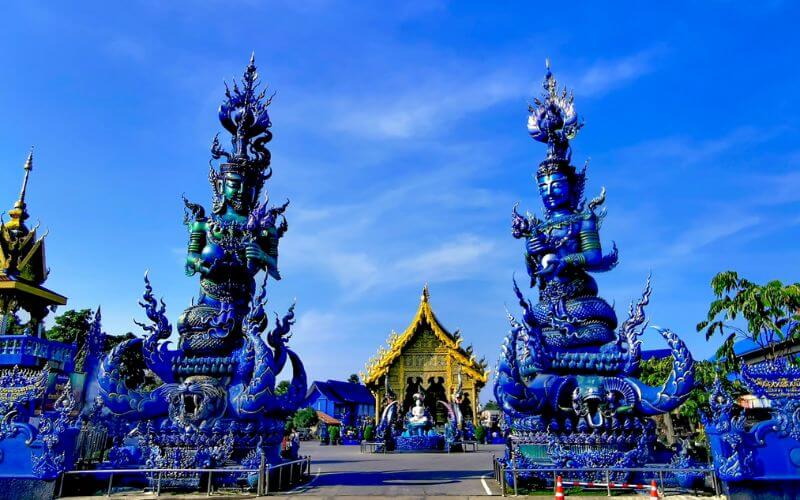
Wat Rong Suea Ten – Chiang Rai
Wat Phra Kaew
Wat Phra Kaew located on Trairat Road is one of Chiang Rai’s most famous temples because it is where the sacred Emerald Buddha was kept since 1444 before being moved to Wat Phra Kaeo in Bangkok, with a few stops in Lampang and Vientiane. Wat Phra Kaew now has an official replica of the Emerald Buddha in green jade. It is also the house of a 700-year-old bronze statue of Phra Chao Lan Thong in Chiang Saen’s ubosot style, which is hard to find elsewhere.
Baan Dam, Black House
The Black House is a large museum displaying the works of a famous local Thai artist. Many buildings, all constructed of heavy, dark wood and metal are arranged around a garden. Each building is filled with eerie and haunting art collections and installations constructed almost entirely from animal skins and skeletons. All artworks are artistically and symbolically arranged, and not just to shock people. Each piece is meant to illustrate Buddhist philosophy, and the collection is worth seeing, especially since it is a contrast to the White Temple.
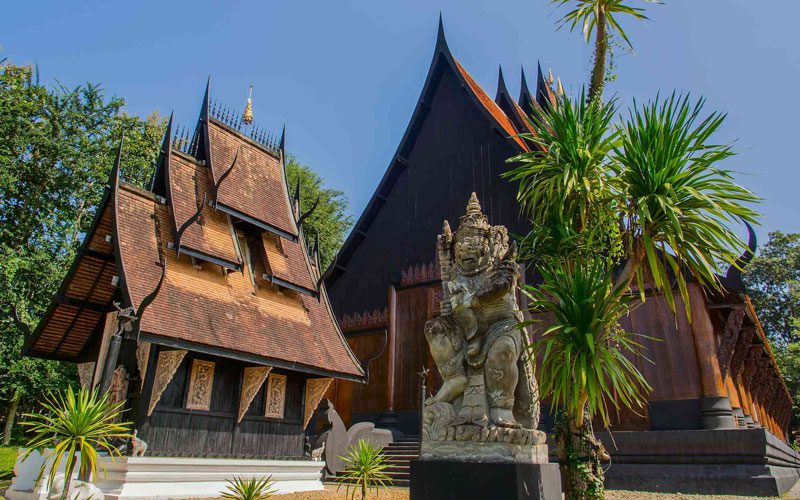
Baan Dam – The Black House
Singha Park
A great getaway for the whole family, Singha Park is a huge place full of nature and great for walking. Located in the countryside surrounding Chiang Rai, the park has many lakes and grasslands to explore. There’s even a working farm with a petting zoo where you can feed zebras and giraffes.
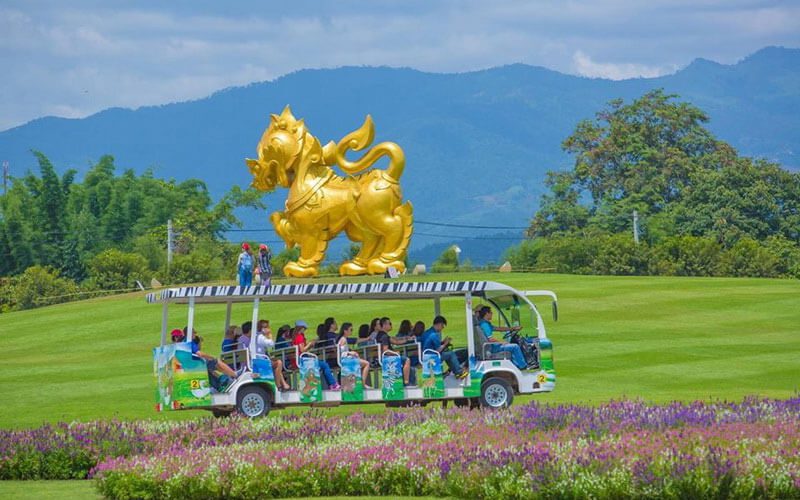
Singha Park
Beautiful landscape! It’s a scenic location with lots of bike paths and trails that nature lovers will admire. In addition to these amazing natural assets, there is a zip line and a climbing wall for those who like more extreme activities.
Wat Huai Pla Kang
Wat Huai Pla Kang is home to Chiang Rai’s “Big Buddha” (which is actually a statue of Guan Yin, the Goddess of Mercy) and a temple with nine floors of the chedi. Climb nine floors to reach the top of the pagoda or take an elevator to the top of the Guan Yin statue to enjoy the view of the surrounding countryside.
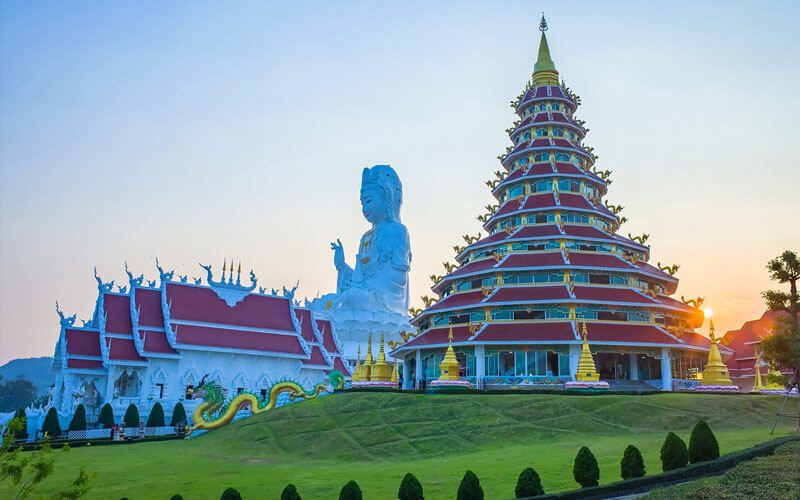
Wat Huai Pla Kang
Golden Clock Tower
Located in the heart of the city, the Golden Clock Tower is spectacular and properly the most majestic roundabout you will see in Thailand. Although traffics circle around it all day, the clock is a great work of art and it is one of the main tourist attractions of Chiang Rai.
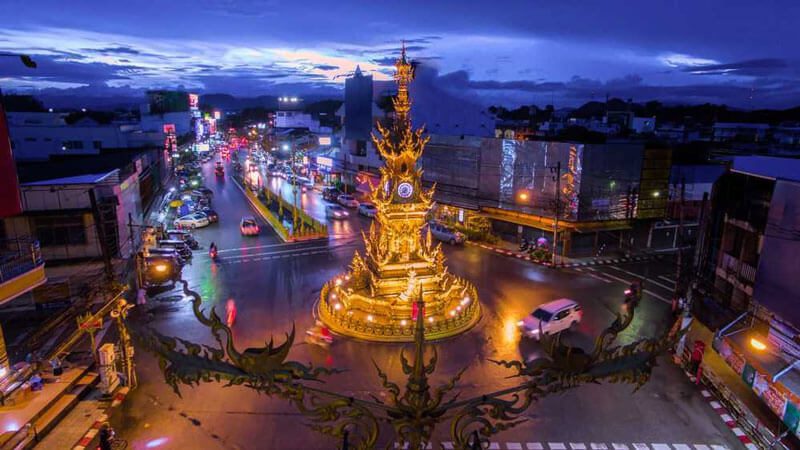
Golden Clock Tower – Chiang Rai
Designed by the same artist who created the White Temple, the clock tower is even more incredible in the evening when a show of sound and lights highlights it even more against the night sky.
Night Bazaar Market
The Night Bazaar Market opens daily from 6 pm is one of the busiest night markets in Chiang Rai, especially in the late evening. More than 300 booths offer food, jewelry, and gifts, as well as live entertainment. Restaurants and brasseries are available near the two stages of the shows. The first stage is traditional Thai dance and classical music by Chiang Rai University students. The second stage is for cabaret performances, songs, and hill tribes performances.
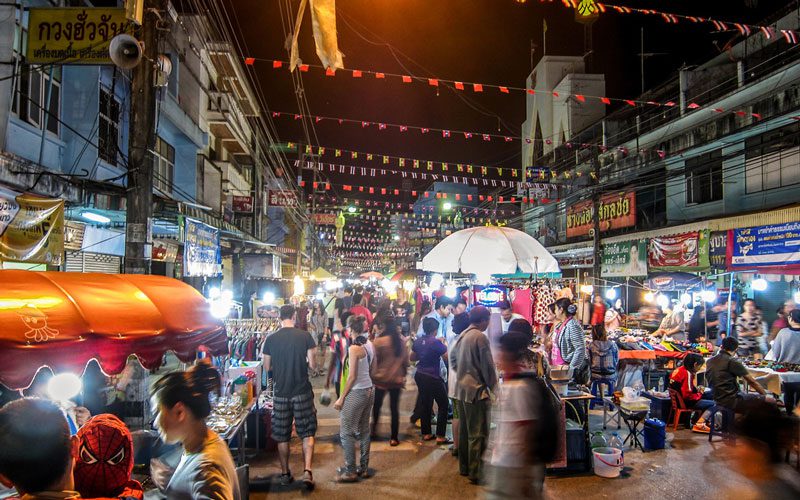
Night Bazaar Market – Chiang Rai
Chiang Rai Walking Street
Chiang Rai Walking Street unfolds every Saturday evening in the center of Chiang Rai. It is a family-friendly place where you can buy handicrafts made by locals and hill tribes villagers, as well as products from royal projects that support disadvantaged communities and ethnic groups. You can get a message, feast on abundant street food, or simply admire the variety of quality products and handicrafts on display here. This is an ideal night market to buy souvenirs to take home.
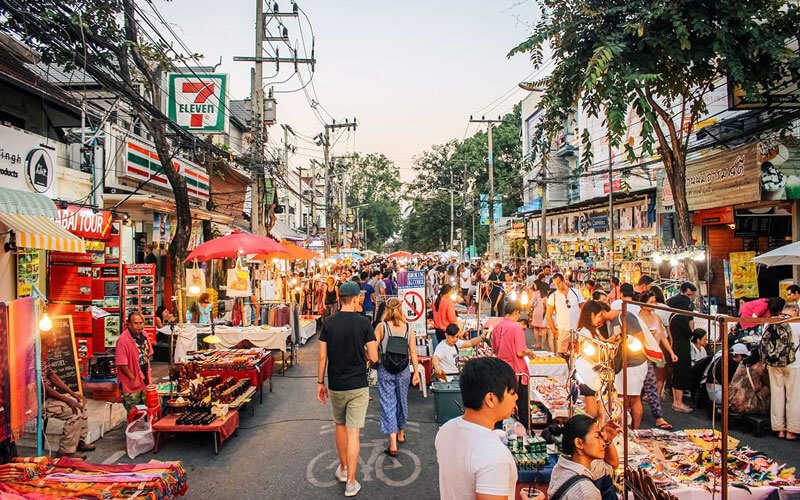
Chiang Rai Walking Street
Oub Kham Museum
The Oub Kham Museum is dedicated to the history and heritage of the Lanna Kingdom. The museum’s curator Julasak Suriyachai is a descendent of Burmese royalty and a devotee of Lanna culture. He has carefully assembled an impressive collection of artifacts from across the Lanna Kingdom. Here you can find textiles and jewelry, sculptures and statues, pottery, and antiques.
Hill Tribe Museum
Northern Thailand and Chiang Rai in particular is home to many hill tribes, each with their own unique history, culture, and traditions. This museum highlights six garments, folklore, and harvesting equipment from these tribes, among other things, and also offers insight into ongoing community projects. A living institution in many ways, the Hill Tribe Museum will certainly help you to understand more about the richness and diversity of Thailand’s cultural heritage.
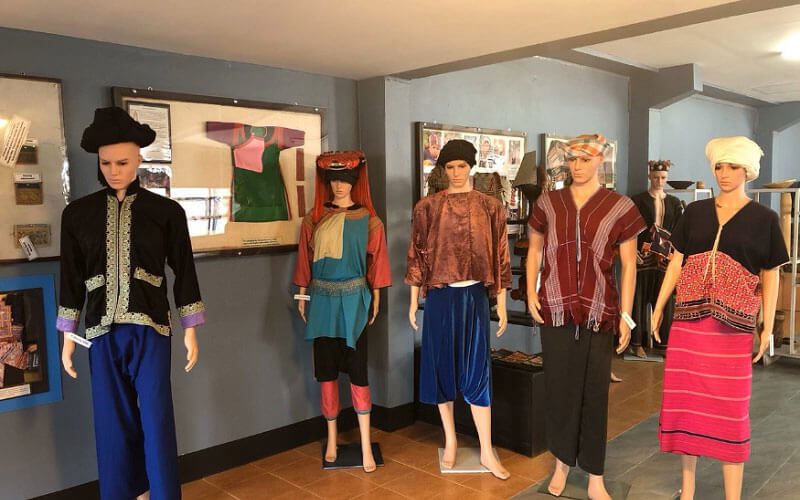
Exhibitions at The Hill Tribe Museum
Khun Korn Waterfall
70 meters high, Khun Korn Waterfall is a real hidden treasure, buried deep in the Khun Korn Forest Park, outside of Chiang Rai. This waterfall is definitely one of the most exquisite places to visit in Thailand. The attraction is not only for the beauty and splendor of the waterfall and greenery but also for the vast rice fields and dense jungles.
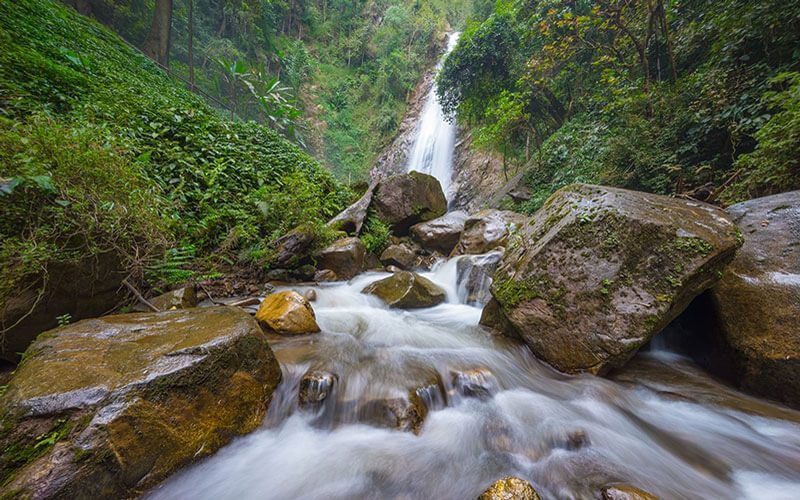
Khun Korn Waterfall
Mae Fah Luang Cultural and Art Park
This park is home to the largest collection of teak art and artifacts in the Lanna Kingdom in Northern Thailand and has been awarded as an Outstanding Tourism Destination for Arts and Culture. This extraordinary destination is both a museum and a landscape, as it is located in a beautiful garden that is so pleasant to walk through at any time of the day.
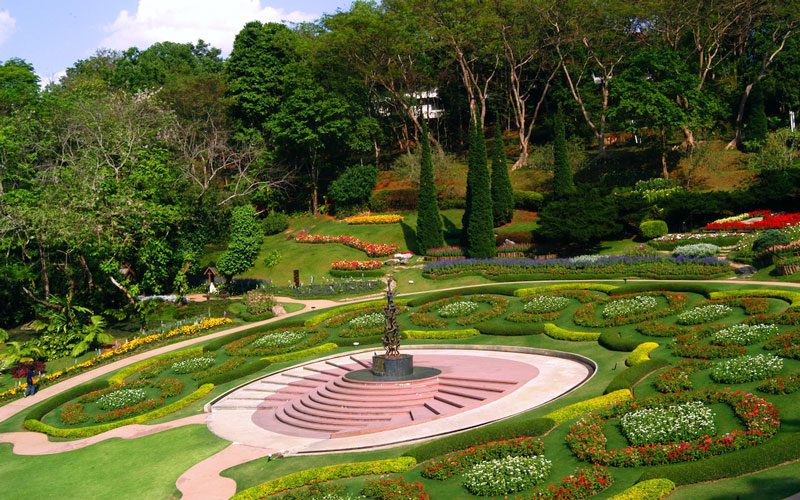
Mae Fah Luang Cultural and Art Park
Attractions around Chiang Rai
The Golden Triangle
The Golden Triangle is known for its dark history as well as its current status as a splendid travel destination. Once a center of opium production and distribution, today, the Golden Triangle is filled with verdant jungles, towering mountains, hill tribe villages, and opium-free farmland. Come and see how history changed people over time, and see how the natural landscape remains healthy and unchanged along two ever-flowing rivers.
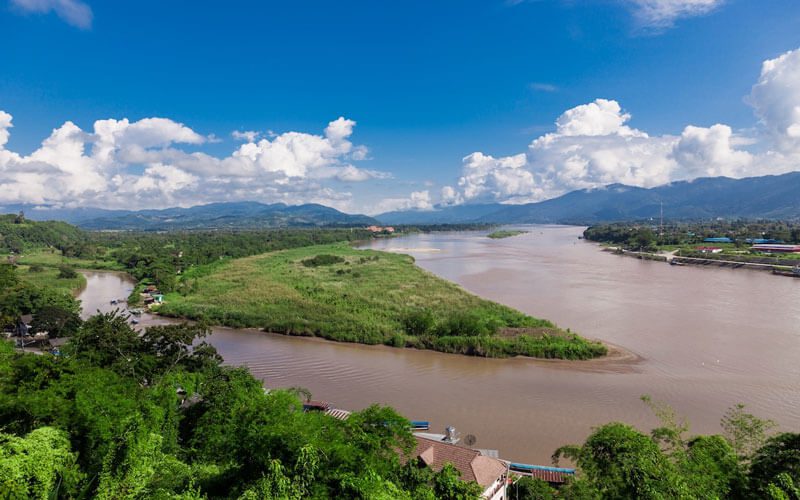
The Golden Triangle
Mae Sai
Mae Sai located 60 km to the North of Chiang Rai, marks the border with Myanmar. The city is particularly popular with backpackers for a good reason: it is the perfect place to extend your visa when leaving and returning to Thailand.
All you have to do is cross the bridge that connects the city to Burma and make the trip in the opposite direction for your visa to be renewed. Mae Sai is also known for its huge border market with the town of Tachileik where you can buy typical products of the region or very cheap cigarettes and alcohol.
Doi Mae Salong
One of the most fascinating villages in northern Thailand, Doi Mae Salong, was founded by a community of Chinese soldiers, alongside the Chin Haw ethnic minority. The culture is completely different from the rest of the country – everything here has a distinctly Chinese flavor, especially the food! Take the opportunity to taste the tea here. The region is famous for the cultivation of oolong tea, which you can see cascading down the sides of the mountains.
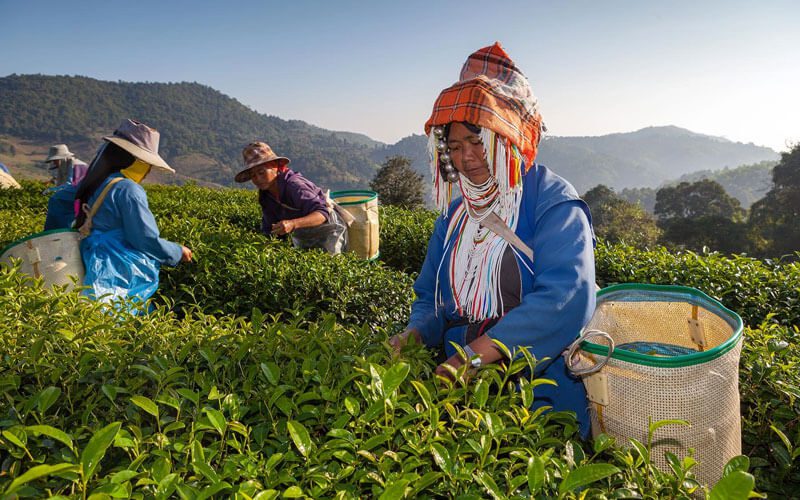
Doi Mae Salong – Chiang Rai
Best Restaurants in Chiang Rai
Tong Tung Restaurant
Tong Tung Restaurant promises authentic northern Thai cuisine and some adventurous dishes for daring travelers. The most delicate dish is steamed whole fish, usually accompanied by vegetables and a fiery chili paste marinade. There are also hot tom yum soups and traditional regional curries filled with spices and mung beans.
Chiang Rai Roast Duck Shop
The Chiang Rai Roast Duck Shop offers many dishes which all have roasted duck based. Some are served with sweet plum sauces, others with hot peppers. You can also enjoy great side dishes, which range from garlic and soy to noodles and vegetable broths. Another advantage is eating here won’t cost you too much.
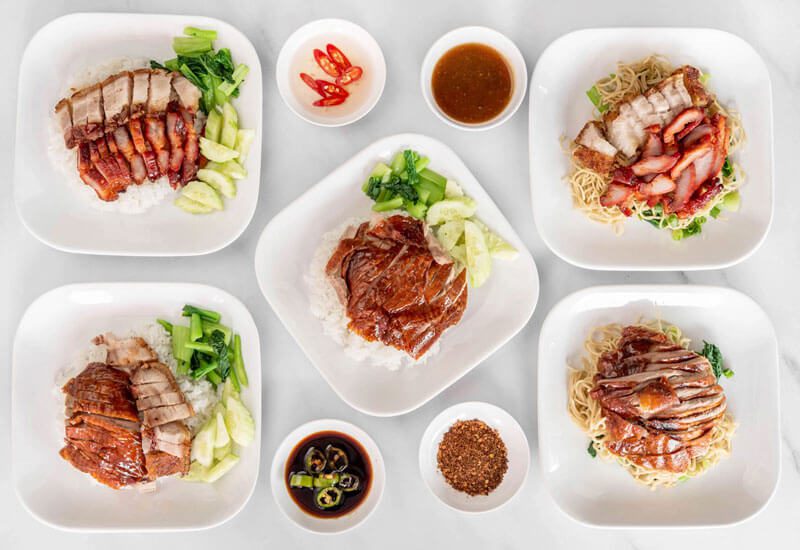
Chiang Rai Roast Duck Shop
Khao Soi Restaurant
Khao Soi Restaurant is a small, compact kitchen run by friendly chefs with a daily changing menu of 5 or 6 Thai dishes. Fried tofu cubes, pork broths, crispy noodle salads, and fried fish skins are part of the offer. However, there is one dish that stands out. This is khao soi (noodles with chicken and curry). Order these and you’ll get a combination of chicken with shallots, soy, and ginger that will leave you speechless.
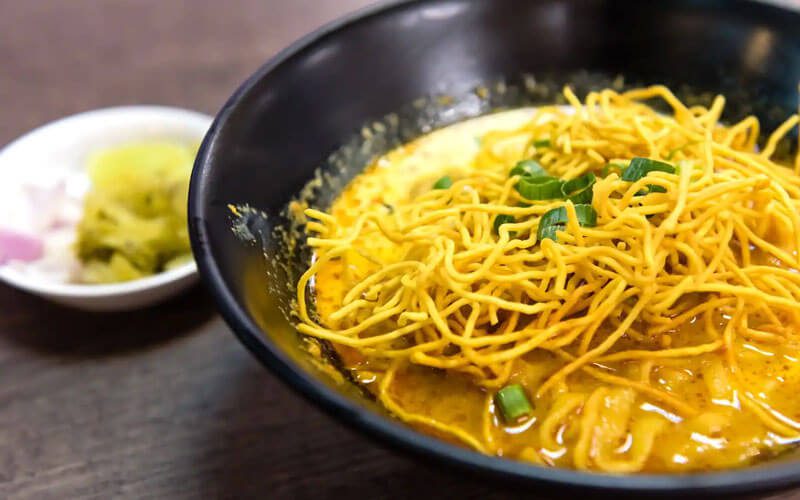
Khao Soi
Boonsita Vegetarian Restaurant
Boonsita Vegetarian Restaurant is a must-visit spot in Chiang Rai for those who want to enjoy traditional meatless cuisine. It doesn’t look like it, but the whole menu is vegetarian. Mushrooms and soy protein replace the gristle of pork and beef to give a taste of traditional Northern Thai curries and stir-fries. You can order each dish separately or choose the buffet option, which usually includes 6 or 7 separate vegetarian options.
Chiang Rai has it all, from culture and history to local food. Contact us now if you want more information or private consultation for planning a trip to Thailand!